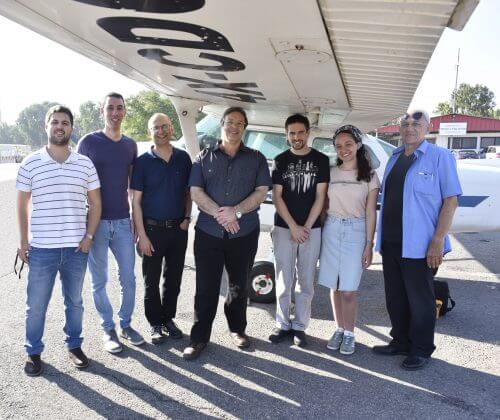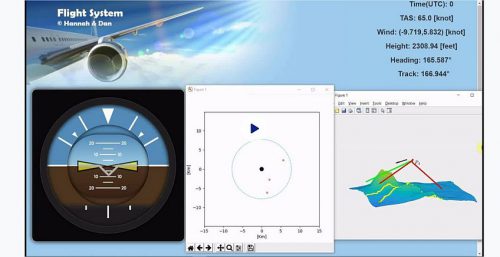Students from the Viterbi Faculty of Electrical Engineering at the Technion have developed a smart guidance system for landing planes whose engines have been disabled

Photo credit: Sharon Shafam, students and supervisors. From right to left: Dr. Aharon Bar-Gil, Hana and Dan Straussman, Prof. Nachum Shimkin, Kobi Kokhei, Alon Yeroshinski and Amri Freund
Photo credit: Sharon Tzur
On January 15, 2009, the engines of an Airbus A320 were disabled in the air, shortly after takeoff, as a result of a collision with a flock of geese. Fortunately, pilot Chelsea Sullenberger was able to land the plane on the Hudson River, a decision that apparently saved all passengers and crew, 155 people in total.
Shutting down engines is not a rare phenomenon, and according to the US Federal Aviation Authority (FAA), one of the main causes of flight accidents, including fatal accidents, is shutting down engines. The danger of this phenomenon is particularly great when it comes to light aircraft, which are not equipped with sophisticated control and backup systems and whose pilots do not undergo extensive training like the pilots of passenger planes. The aforementioned situation is especially dangerous when the weather is stormy, and the glide to the potential airstrips requires bypassing high areas. In such a case, the pilot is required to choose the landing destination and plan the arrival there taking into account the winds, the ground route, no-fly zones and more. It is important to note that the wind profile affecting the aircraft changes during the glide, so a re-calculation of the route is required based on the new data at every moment.
This is the background for a series of studies conducted at the Technion to develop a technological solution to these situations, that is, to provide an optimal solution for a situation where an airplane's engines are disabled and it needs to glide and reach a safe landing. These studies began in the research group of Prof. Yossi Ben-Asher from the Faculty of Aeronautics and Space Engineering, and in the last decade they have been led by Prof. Nachum Shimkin, the current dean of the Faculty of Electrical Engineering at Viterbi, together with Dr. Aharon Bar-Gil, an adjunct senior lecturer in the faculties of electrical and aeronautics and space engineering. The studies are conducted in collaboration with the Ministry of Defense.

After extensive theoretical work on the subject, the findings were implemented as part of a bachelor's degree student project in the laboratory for control, robotics and computational learning at the Faculty of Electrical Engineering, led by laboratory engineer Kobi Khokhei. Two undergraduate student teams worked on the practical application: Omri Freund and Alon Yoroshinsky, who implemented the optimal route labeling algorithm in real time; and Hanna and Dan Straussman who developed a display system for the pilot and sensor interfaces and carried out the software and hardware integration for the airborne test. The students were guided by Dani Segal, who was a partner in this research as part of his master's degree studies under the guidance of Prof. Shimkin and Dr. Bar-Gil. "The theoretical basis for calculating the optimal glide path was presented in a series of articles, the last of which was published in May 2019 in AIAA J. GCD - a leading journal in this field, produced by the American Institute of Aeronautics and Astronautics." "It is particularly gratifying to see the theoretical research conducted on the subject come to successful realization in the cockpit," said Prof. Shimkin. "Thanks go to the team of students, instructors and pilots who devoted the best of their talent and time to the realization of the system, and to the ongoing support of Mpaat in the project."
According to Dr. Bar Gil, "despite the rapid technological progress in the world of aviation, there has been no significant decrease in the number of air accidents nor in the number of fatalities. The good news is that a system of the type developed by the students may prevent accidents and save lives."
The research and engineering groups faced a series of challenges, including the necessity to avoid connecting their experimental system to the aircraft's systems. That's why they needed creative solutions, including a real-time evaluation of the direction and strength of the wind, with the smart help of the navigation system loaned to the Technion. The students also built a simulation of the plane's movement according to the optimal algorithm and of tracking guidance for the pilot - to improve the system as much as possible even before the actual flights.
On July 30, 2019, the system was tested in such an actual flight courtesy of pilots Mike Dvir and Yuval Dvir and airborne test engineer Shlomi Schwartz. The flight, which was conducted in the vicinity of Mount Tabor, simulated a situation of shutting down an engine over Kiryat Tivon and the entry of the technical system into action. The algorithm located two possible airstrips east of the mountain, calculated the route to the preferred target and presented the pilot with a marker that guided him to the preferred airstrip. The results: the plane successfully bypassed the Tabor, and the pilot testified in retrospect that the guidance was successful and also the human engineering of the road sign for the pilot was efficient and convenient.
It is worth noting that the algorithm developed at the Technion may also be used as a mechanism for the emergency landing of a UAV (unmanned aerial vehicle) whose engine has stopped working.

2 תגובות
Sakhtein, great faculty (;
Very impressive, well done